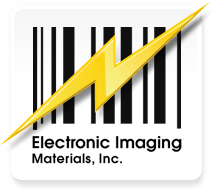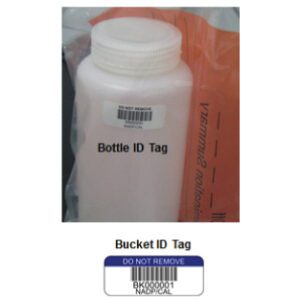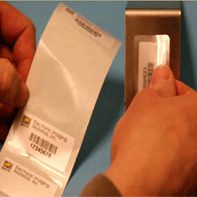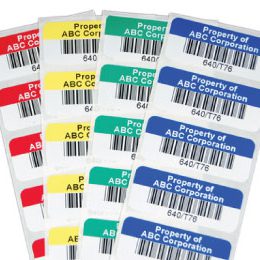Medical devices are getting smaller, smarter, and more connected. But behind every device is a label, and behind every label is a supply chain that must be accurate, secure, and accountable. As regulatory demands tighten and the threat of counterfeiting rises, manufacturers are under pressure to adopt tools that go beyond basic tracking. They need labeling systems that can verify, protect, and connect data across the product’s lifecycle.

Blockchain medical device labeling is emerging as a powerful answer. By linking secure digital ledgers with physical label data, blockchain enables traceability, strengthens security, and simplifies compliance. Rather than simply digitizing information, blockchain validates it at every step. Here’s how this evolving technology is reshaping the way medical device labels are created, tracked, and trusted.
What Is Blockchain and How Does It Relate to Medical Device Labels?
Blockchain is a decentralized, tamper-resistant ledger that records transactions across multiple computers. Once data is recorded, it becomes virtually impossible to alter without consensus from all participants. In medical device labeling, this means that every time a device moves, changes hands, or undergoes an update, the event can be logged in an immutable and transparent manner.
This is especially important in a space where every label must be accurate, every device must be traceable, and every supply chain step must be audit-ready. For manufacturers managing complex product lifecycles, international distribution, or strict compliance standards, blockchain creates a visible, verifiable, and secure chain of custody without relying on a single, centralized database that might be vulnerable.
Key Benefits of Blockchain Medical Device Labeling
The value of blockchain goes beyond the hype. Below are several specific ways it can enhance labeling operations for medical devices:
Immutable Traceability Across the Supply Chain
Medical device traceability is essential. A single point of failure or a missing label can lead to recalls, regulatory penalties, or even patient harm. Blockchain records each transaction or movement permanently, offering a timeline of who did what, when, and where.
When a label is generated and applied to a device, that event is recorded in the blockchain. When the device is shipped to a hospital, that becomes another entry. Each point of inspection, use, or service is logged, resulting in a complete record that is consistent and easy to verify.
Increased Label Data Security and Authenticity
Traditional label data systems are vulnerable to manipulation. Inaccurate or falsified data (whether intentional or accidental) can lead to severe consequences. Blockchain reduces this risk by encrypting and distributing information across a network, making it extremely difficult to alter past entries without detection.
This significantly improves secure medical device tracking and helps ensure that the printed label always matches the original source of truth. Elements such as barcodes, UDI numbers, expiration dates, and lot codes can all be linked to blockchain records for validation.
Real-Time Visibility and Regulatory Alignment
The FDA and global regulatory bodies are increasingly prioritizing transparency. Blockchain technology aligns with this by enabling real-time access to verified data for regulators, manufacturers, and healthcare providers.
Instead of waiting for periodic reports or scrambling to locate records during an audit, teams can access live blockchain-backed logs. This speeds up reporting, simplifies inspections, and supports faster resolution if corrective action is needed.
Support for Counterfeit Prevention
Counterfeit medical devices continue to pose a growing threat worldwide. By associating each device and its label with a unique blockchain record, manufacturers create a digital fingerprint that can be authenticated anywhere. Hospitals, distributors, or end users can scan a QR code or access a blockchain interface to confirm the legitimacy of the product on the spot.
This not only protects patient safety but also safeguards brand reputation and financial performance.
How Blockchain Solutions Pair With Labels in the Field
The benefits of blockchain medical device labeling are already being realized in real-world scenarios. Here are a few examples of how it is being applied:
- UDI Integration: Blockchain platforms can store and verify UDI data as part of a device’s digital twin, ensuring its accuracy throughout the product’s life.
- Sterilization Tracking: Labels with timestamps and sterilization batch numbers can be linked to blockchain entries that verify each cycle.
- Loaner Instrument Sets: Reusable surgical kits can be monitored as they move between facilities, with each usage and maintenance cycle captured on the blockchain.
- Field Service Management: Devices serviced in the field can have their labels scanned or updated to log maintenance history, replacing the need for paper-based tracking.
These examples help reduce manual errors, enhance accountability, and make compliance a built-in component of everyday workflows rather than a separate burden.s, UV-curable inks offer a dependable solution that bridges the gap between quality and speed.
Electronic Imaging Materials, Inc. partners with innovative manufacturers to evaluate labeling workflows and strengthen traceability, security, and compliance. If you’re exploring future technologies like blockchain or looking to modernize your label infrastructure, we can help you take the next right step.
Barriers to Adoption: What Slows Blockchain Down?
While the potential of blockchain medical device labeling is significant, adoption is not without its challenges. Recognizing and planning for these issues is essential to developing an effective rollout strategy.
Integration Complexity
Most existing labeling systems were never designed with blockchain in mind. Adding blockchain capability often requires changes in architecture, workflows, and sometimes even hardware. Successful integration requires collaboration across IT, supply chain, and compliance teams to ensure the new technology fits without creating disruption.
Network Participation
Blockchain systems provide the greatest benefit when multiple parties participate. However, the medical device ecosystem is often fragmented, with different stakeholders using different tools and systems. Encouraging suppliers, regulators, and customers to participate requires coordination and a shift in operational culture, not just new software.
Regulatory Clarity
While regulatory bodies are beginning to embrace greater transparency, many have not yet defined how blockchain data should be used or reported. Manufacturers must stay informed and ensure that any blockchain-based solution aligns with both current and future regulatory expectations.
Upfront Investment
Adopting blockchain involves upfront costs, from staff training and software development to vendor selection and testing. Yet these costs are often offset by long-term benefits such as reduced compliance risk, fewer data errors, and improved operational efficiency.
Where Blockchain and Labeling Are Heading
Blockchain medical device labeling represents just the beginning of a larger transformation. As the technology evolves, expect to see integration with:
- Smart labels and environmental sensors that automatically log data such as temperature or humidity to the blockchain
- AI-powered tools that identify trends or anomalies in device history based on immutable records
- Cloud-based regulatory dashboards that connect directly with labeling systems for continuous audit readiness
The goal is to move toward a fully connected and intelligent labeling system that adds value well beyond identification and compliance.
Let EIM Help You Build Smarter, Safer Labeling Systems
At Electronic Imaging Materials, we believe labels do more than identify. They protect, inform, and enable traceability throughout a device’s lifecycle. As medical labeling requirements grow more complex, we support manufacturers with solutions built for durability, compliance, and future-ready performance.
While blockchain integration may be part of your long-term vision, our current focus is helping you build a strong foundation for traceability and security through expert labeling.
We offer:
- Label design and printing solutions tailored for regulatory compliance and data capture
- Material recommendations optimized for sterilization, durability, and scannability
- Consultations on labeling workflows to help streamline operations and reduce errors
You don’t need to overhaul your systems to make progress. With the right labeling strategy, you can move toward smarter, more secure processes at your own pace.
Ready to enhance your labeling performance? Let’s talk about what’s next.





